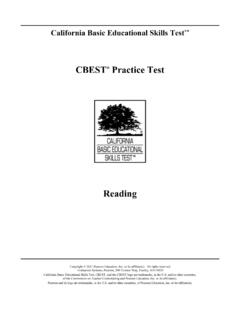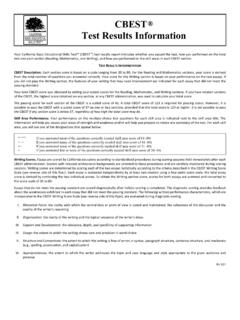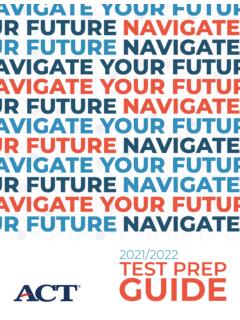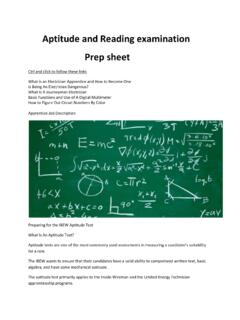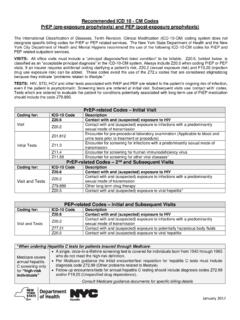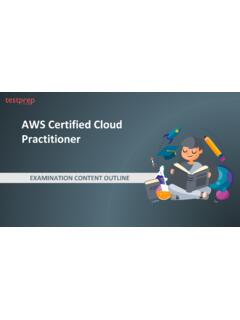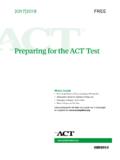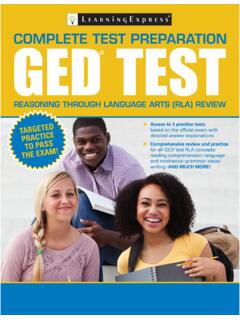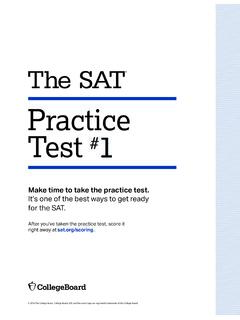Transcription of CSET: Multiple Subjects Practice Test Subtest I
1 California subject Examinations for Teachers (CSET ) CSET: Multiple Subjects Practice Test Subtest I Reading, Language, and Literature; History and Social Science Copyright 2014 Pearson Education, Inc. or its affiliate(s). All rights reserved. Evaluation Systems, Pearson, Box 226, Amherst, MA 01004 California subject Examinations for Teachers, CSET, and the CSET logo are trademarks of the Commission on Teacher Credentialing and Pearson Education, Inc. or its affiliate(s). Pearson and its logo are trademarks, in the and/or other countries, of Pearson Education, Inc. or its affiliate(s). Multiple Subjects Practice Test: Subtest I TABLE OF CONTENTS Introduction and Test Directions.
2 1 Multiple -Choice Answer Sheet .. 2 Multiple -Choice Questions .. 3 Constructed-Response Directions and Evaluation Recommendations .. 25 Constructed-Response Assignments and Response Sheets .. 26 Acknowledgments .. 34 Results .. 35 Multiple Subjects Practice Test: Subtest I 1 INTRODUCTION This Practice test is a full-length sample test consisting of 52 Multiple -choice questions and four constructed-response assignments. An answer sheet for the Multiple -choice questions, blank response sheets for the constructed-response assignments, and a Domain Results Worksheet for each domain are also included. TEST DIRECTIONS This Practice test consists of two sections: (1) a Multiple -choice question section and (2) a constructed-response assignment section.
3 Each question in the first section of the Practice test is a Multiple -choice question with four answer choices. Read each question carefully and choose the ONE best answer. Record each answer on the answer sheet provided on page 2. The second section of this Practice test contains constructed-response assignments, which require written responses. Directions for the constructed-response assignments appear immediately before those assignments. You may work on the Multiple -choice questions and constructed-response assignments in any order that you choose. You may wish to monitor how long it takes you to complete the Practice test.
4 When taking the actual CSET: Multiple Subjects , you will have one five-hour test session in which to complete all three subtests. If you register to take just Subtest I, you will have one three-hour test session in which to complete the Subtest . Multiple Subjects Practice Test: Subtest I 2 Multiple -CHOICE ANSWER SHEET Reading, Language, and Literature Question Number Your Response 1 2 3 4 5 6 7 8 9 10
5 11 12 13 14 15 16 17 18 19 20 21 22 23 24 25 26 History and Social Science Question Number Your Response 27 28 29 30
6 31 32 33 34 35 36 37 38 39 40 41 42 43 44 45 46 47 48 49 50 51 52
7 Multiple Subjects Practice Test: Subtest I 3 Multiple -CHOICE QUESTIONS 1. Some common vowel patterns are associated with more than one pronunciation ( , steam and bread). Which of the following nonsense words illustrates a vowel pattern that is highly consistent in its pronunciation? A. stook B. troan C. spow D. mough 2. Oral rhyming activities are most likely to promote phonemic awareness by helping a child learn to: A. attend to the sounds shared by words in the same word family. B. identify the junctures between syllables in spoken words. C. recognize how the structure of a word relates to its meaning.
8 D. identify spelling patterns that correspond to specific sounds. 3. The languages of the world are most similar in which of the following respects? A. the basic principles of phrase structure ( , the subject -predicate structure of sentences) B. the speech sounds that are used to form words C. the basic rules of morphology ( , adding s to a singular noun to make a plural) D. the role of volume in communicating information 4. Which of the following statements best explains how knowing a language that is historically related to English ( , German, French, Spanish) can facilitate an individual's acquisition of English as a second language? A. Many words and roots are likely to have similar spellings and meanings in English and in the individual's first language.
9 B. English prefixes and suffixes are likely to resemble the affixes used in the individual's first language. C. The most frequently occurring speech sounds in English and in the individual's first language are likely to be the same. D. Social conventions relating to language use are likely to be similar in English and in the individual's first language. Multiple Subjects Practice Test: Subtest I 4 5. According to current research, reading difficulties that are not the result of limited intelligence or lack of educational opportunity are most often caused by: A. poorly developed visual discrimination skills. B. a deficit in phonological processing. C.
10 Poorly developed oral language abilities. D. a lack of motivation. 6. An extensive oral vocabulary is most likely to contribute to a reader's decoding skills by helping the reader: A. apply phonics generalizations to sound out a word. B. use syntactic cues to determine the meaning of an unfamiliar word. C. relate an unfamiliar word to known words with similar spellings. D. recognize a word after sounding it out. 7. Which of the following phonemic awareness skills typically is easiest for children to acquire? A. identifying the initial sound in a word ( , /b/ in bed) B. recognizing that two words contain the same sound ( , thin and path) C. blending sounds together to form a spoken word ( , /t/ + /a/ + /g/ = tag) D.

